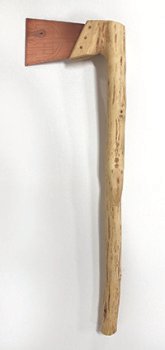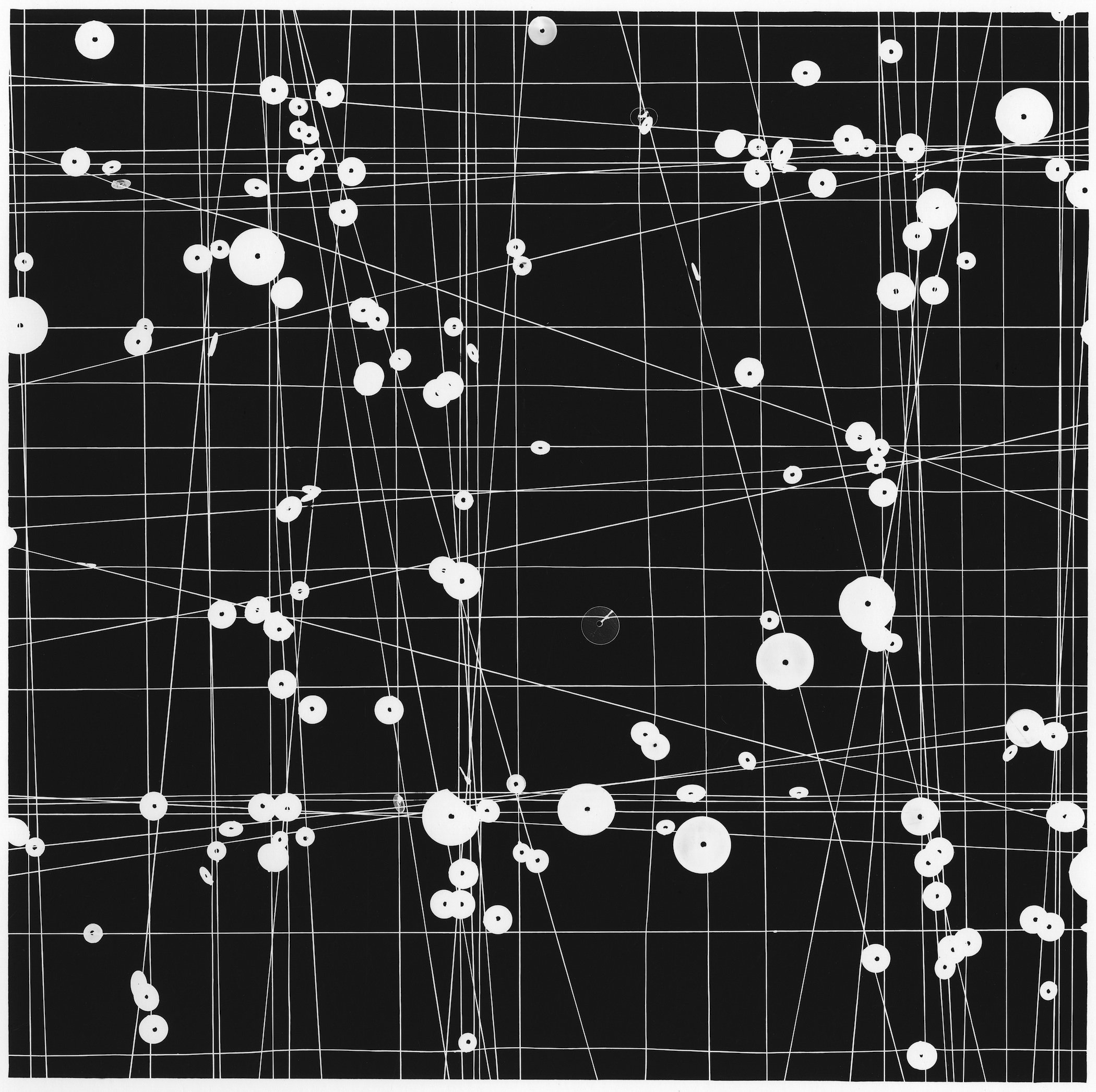Sanctus
September 27 – November 20, 2015
Opening Reception, Sunday, October 4, 2015, 3 to 6pm
Christian Brown, Two Hands of God, 2013, Oak and copper, approximately 24 X 8 inches
M. Benjamin Herndon, Scholar’s Rock, No. 1, 2014, Found carburetor; paper and wood tabletop, metal base; six photolithographs on Japanese paper inset in table. Table: 40 X 16 X 19 inches; carburetor: 6 X 8 X 6 inches
SINCE PREHISTORY, humans have been impressed by skill, prowess, and by those individuals believed to have magical abilities. There was the hope that these attributes might be transferred or preserved in some way after death. It came to be believed that the essence of a person was still present in their physical remains post mortem and that essence could also be transferred to the objects associated with the person. Relics are the physical remains or the objects associated with a person who was deemed special in some way. These elevated items were treasured for the power with which they were imbued and for their ability to transfer that power to the living.
Many cultures venerate relics. Some, like the ancient Greeks, used them for incentives or inspiration. The armor of a fallen hero would be displayed to encourage heroism in living soldiers. Buddhist relics exist to show proof that enlightenment is possible. Other cultures ascribe great power to relics which is manifest though the alleged way the objects affect those who come into contact with them. The Mayans believed that to wear the skin of a jaguar gave one the attributes of the animal. The prehistoric people of Jericho, believed that to recreate the features of dead ancestors on their dry skulls was to manifest the dead back as a protectorate of the family. In many European cultures with strong Catholic beliefs, the parts of deceased individuals who were believed to be especially beloved by God were honored as tools through which the will of God could be channeled to achieve the miraculous. It is important to understand this distinction by the Catholic Church. The relics have no special power in themselves, lest there be a belief in Paganism. Instead, the relics are a way to focus the omnipotence of God and allow His power to manifest in the supplicants’ life.
With Sanctus, Curious Matter is delving into the freighted waters of the relic and reliquary. The container for holy relics can be as simple as a rock slab pedestal, such as that which displays the bear skull at Chauvet Cave. This simple gesture sets the object apart from the world and notifies the viewer that this is something extraordinary. The container for the relic may also be elaborate and precious, designed to illustrate the glory of heaven to the faithful, as those found in countless churches. The relic can be anything that is perceived to have some special power. The object can be anything, but it needs to be venerated and it needs to have either folk proof of its magical power, or historical value to promote heroism, or patriotism in the viewer.
Christian Brown’s Two Hands of God, is an example of an object of worship. His ax-like sculpture recalls the ceremonial tools of the shaman to fight evil spirits and protect the tribe from the pestilence of the surrounding mortal world. Like the sécespita[1] of ancient Rome or the athame[2] of the modern Wiccan, it has the appearance of a ritual object whose use may be for blood letting or as a metaphor for the channeling of the energy of the thrust or cut.
M. Benjamin Herndon’s Scholar’s Rock, No.1 takes an object, in this case a carburetor, and elevates it from its utilitarian purpose into an aesthetic meditation. As the Chinese scholar’s rocks that it is named after, once the object is placed in its vaunted position, it is up to the viewer through meditation on the form, to bring meaning and value to the piece. Like its oriental counterpart, Herndon has created works on paper as a paean to the object, which increase its preciousness and worth as an art object. Gilbert Hsiao’s Composition with Three Records, is another object of meditation. Here, the artist has utilized the form of the mandala as the meditative focus. The mandala is the gateway into the spiritual realm for the seeker. Hsiao has created his entrance to this realm as a circle within a circle; a tunnel to infinity. It has the additional secret potential of being a kinetic work. It can be placed on a turntable and spun to achieve a hypnotic state in the viewer.
In the Metropolitan Museum of Art, there is a gilded reliquary that contains a tooth purported to be from Mary Magdalene. Whether or not this tooth is in fact from the Magdalene’s mouth can only be guessed or left for the faithful to assert. It is however a true Catholic relic of the first order in an elaborate display from the 14th century. Lauren Jo is channeling the anonymous goldsmith of the Magdalene reliquary with her Memento Mori: A Bone to Pick. Like Egaeus displaying his odontophobia in Poe’s “Berenice”, we are fascinated and yet repelled by Jo’s depiction of the teeth, which she has presented as more fitting as a curiosity, than the Metropolitan’s hallowed tooth. In this same macabre direction of human relics, are Cristin Millett and Linda Tharp. As does Lauren Jo, Millett’s Sever: Agatha’s Offering incorporates a body part, in this case, the breast. St. Agatha was an early Christian martyr of Rome, who at 15 years of age dedicated her virginity to Christ. When she refused the advances of a Roman prefect, he sent her first to a brothel, where she maintained her purity. The madam of the brothel, perceiving her uselessness for her purpose, returned her to the prefect. The prefect, incensed with Agatha’s fortitude, then imprisoned her and began a series of tortures, the most frequently referenced being the severing of her breasts with pincers. Millett depicts this act of Agatha’s travails by placing the breast and a pomegranate on a gilded tray, perhaps with Agatha’s own hands. Both items are potent symbols of the arduous journey of the spiritual.
Linda Tharp’s Sacré Coeur, brings to mind the Shroud of Turin or Veronica’s Veil as a cloth stained with holy blood. It also brings to mind Laura Keen’s dress stained with the blood of Lincoln or the pink suit of Jacqueline Kennedy, marred with the blood of John Kennedy. The red stain is powerful as an invocation of violence and death. Blood is the life force, the vital liquid that keeps us alive. The color red brings that image into focus and reminds us of its preciousness.
Sanctus brings together artists who, regardless of their creeds, venerate the object. We can look upon these works and understand their preciousness and their need to be separated from the everyday world and placed apart. In each it brings us closer to that indefinable humanness of art making.
CURIOUS MATTER
[1] a ceremonial knife from Ancient Rome used for live sacrifice [2] a ceremonial knife in Wiccan practice used primarily by women
THE ARTISTS
Tal Barel
Christian Brown
Arthur Bruso
Michael Dassle
Larry Dell
M. Benjamin Herndon
Aimee Hertog
Gilbert Hsiao
Lauren Jo
Guillaume Légaré
Ross Bennett Lewis
Marianne McCarthy
Cristin Millett
Raymond E. Mingst
Steven Paneccasio
Ari Richter
Anthony Santella
Robert Schatz
Linda Tharp
Tenesh Webber
Lauren Jo, Memento Mori: A Bone To Pick, (White and Gold Incisor, Canine, and Molar sets), 2015, Found crayons, wood, foam, 3 X 4 X .5 inches
Linda Tharp, Sacré Coeur, 2015, Acrylic on wood, 9 X 5 inches
Tenesh Webber, Mid Point 3, 2015, Black and White Photogram, 11 X 11 inches





